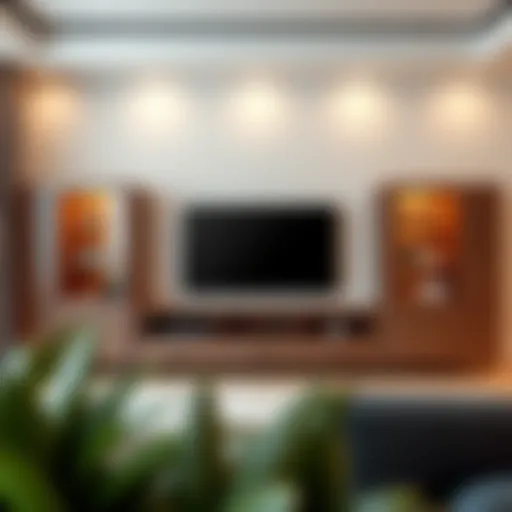Brightening Your Home: The Ultimate Floor Lamp Guide


Intro
In the realm of interior design, lighting often plays an unsung hero role. While wall art, flooring, and furniture tend to steal the spotlight, the choice of floor lamps can redefine a room's character. They do far more than just occupy space; they can establish a mood, highlight architectural elements, or serve as a practical tool for reading and relaxation.
With a myriad of options available to homeowners and enthusiasts alike, choosing the right floor lamp might seem like searching for a needle in a haystack. Different styles, heights, materials, and functionalities contribute to your living environment's ambiance, turning a mundane room into a personalized retreat. This detailed guide aims to illuminate the intricacies of floor lamps, from understanding various designs to practical tips for selecting the one that resonates best with your individual style and needs.
Now, let’s dive deeper into the enchanting world of floor lamps and see how you can harness their potential to brighten up your spaces.
Furniture Styles and Trends
Modern vs. Traditional: Understanding the Aesthetics
Floor lamps, just like any other piece of furniture, cater to different design sensibilities. Modern styles emphasize minimalism and functionality, characterized by clean lines and a more streamlined look. On the other hand, traditional floor lamps often incorporate ornate details, featuring intricate designs that evoke a sense of warmth and nostalgia.
When selecting a floor lamp, consider the existing furniture and decor in your room. A sleek, metallic floor lamp might clash with a rustic wooden sofa, while a vintage brass lamp could add allure to contemporary spaces. It’s essential to strike a balance that brings harmony to your décor.
Color and Material Trends: What's In and What's Out
As design trends shift, so do the popular colors and materials used in floor lamps. Right now, earthy tones like terracotta, olive green, and soft beige are enjoying a resurgence, allowing lamps to blend seamlessly into their surroundings.
When it comes to materials, sustainable options are gaining traction. Wooden bases, recycled metals, and natural fabrics are not just high on aesthetics but also support eco-friendly living.
- In:
- Out:
- Earthy tones
- Sustainable materials
- Functional designs
- Overly decorative styles
- Harsh neon colors
- Non-biodegradable materials
Selecting a floor lamp isn’t merely about illumination; it's about making a statement that reveals your style and ethos in design. With a clearer understanding of the current trends in furniture style, let's consider how to care and maintain these essential elements in your home.
Furniture Care and Maintenance
Tips for Prolonging the Life of Your Furniture
Keeping your floor lamps and surrounding furniture in pristine condition involves simple maintenance tricks. Regular dusting, avoiding harsh chemicals, and ensuring adequate ventilation are excellent starting points.
- Use soft, dry cloths for dusting.
- Avoid placing lamps near heat sources, which can affect materials over time.
- Check bulbs regularly to avoid electrical issues.
DIY Repair Hacks for Common Furniture Issues
Accidents happen, and knowing a few handy DIY tips can save you both time and money. For instance, if your lamp shade becomes stained, a mixture of vinegar and water can work wonders for cleaning.
Moreover, if the base becomes wobbly or loose, a touch of wood glue can secure it without replacing the entire lamp.
Choosing the right floor lamp and maintaining it isn’t just about looks; it’s an investment in your living space.
By utilizing the right information and understanding trends and care, you set the stage for not only a well-lit environment but also a cohesive aesthetic that speaks volumes of your taste and style. As we continue, this guide will further delve into the various functionalities and practical advice that can help you navigate your quest for the perfect floor lamp.
Understanding Floor Lamps
When it comes to illuminating our living spaces, floor lamps play a pivotal role that goes beyond mere functionality. These versatile fixtures can serve as both a source of much-needed light and a stylish accessory that enhances the aesthetic appeal of a room. Whether you’re redecorating your living room or setting up a warm reading nook, understanding the different aspects of floor lamps is crucial for making informed decisions.
History of Floor Lamps
Floor lamps have evolved significantly over time, with their origins tracing back to ancient civilizations. Initially, forms of these lamps were simple structures—often just a bowl filled with oil placed on a pole. Over centuries, designs became more elaborate, influenced by the artistic movements of their times. For example, during the Art Deco period, floor lamps transformed into iconic pieces that showcased geometric lines and metallic finishes.
As we moved into the modern era, a variety of materials such as plastics, glass, and eco-friendly options became staples in lamp production. This diversification not only reflects technological advances but also caters to diverse tastes and functional needs. Thus, the rich history of floor lamps is not just about light; it mirrors cultural shifts and innovations in design.
Types of Floor Lamps
Knowing the various types of floor lamps is essential in choosing the right one for your space. Here’s a deeper look at different styles:
Traditional
Traditional floor lamps are characterized by classic designs that evoke a sense of nostalgia. They often include materials such as wrought iron or brass, which attract those who appreciate timeless elegance. One key feature of traditional lamps is the use of soft, warm light that fosters a cozy atmosphere.
The beauty of traditional lamps lies in their versatility, making them suitable for various settings—from formal living rooms to intimate reading corners. However, while they certainly add a touch of class, they can sometimes be perceived as outdated in contemporary settings.
Contemporary
In contrast, contemporary floor lamps embody the essence of modern design. These fixtures typically boast clean lines, minimalistic shapes, and innovative materials that catch the eye. The key characteristic here is functionality tied with aesthetic appeal, perfect for homeowners looking to make a statement while maximizing utility.
One advantage of contemporary lamps is their adaptability; they fit seamlessly into various interior themes—from industrial to Scandinavian styles. Yet, their bold nature might not align with all design sensibilities, potentially overshadowing other elements of a room.


Arc
Arc lamps stand out with their curved design that allows for a greater reach while occupying minimal floor space. The highlight of an arc lamp is its ability to provide overhead lighting without the need for ceiling fixtures. This is particularly beneficial in spaces lacking built-in lighting.
These lamps serve as dramatic focal points, gracefully extending over seating areas. Their unique silhouette complements modern and eclectic styles, yet may require careful placement to avoid overwhelming a room's scale.
Torchiere
Torchiere lamps are a popular choice due to their upward-facing shades that diffuse light across the room. Their main asset is the indirect lighting they provide, creating a soft and inviting ambiance. It's often said that a well-placed torchiere can change the entire feel of a space.
With a variety of finishes and styles, torchiere lamps can easily blend into both casual and formal settings. Nevertheless, while they provide excellent ambient light, they may not be sufficient for tasks such as reading or working unless paired with another light source.
Lamps with Shelves
Combining lighting with storage, lamps with shelves offer a functional twist to traditional floor lighting. They are excellent for small spaces, serving a dual purpose of illumination and display. The key advantage here is the practicality; you can showcase books, plants, or decorative items while brightening up your room.
However, these lamps may not always deliver the kind of focused light other styles can provide. Homeowners need to balance their aesthetic and functional needs when considering this option.
Importance of Light Output
When it comes to selecting a floor lamp, understanding light output is paramount. It's not merely about choosing something that looks nice in the corner of a room. The right light output can transform an ordinary space into one that is inviting and functional. Proper illumination not only affects how a room feels but also impacts how the activities within that space are carried out. Without the right amount of light, tasks such as reading or working can become tedious or even impossible. This guide delves into the nuances of light output, which is often misunderstood or overlooked by many homeowners and designers.
Understanding Lumens
The term "lumens" is essential when discussing light output. Unlike wattage, which indicates energy consumption, lumens measure the actual brightness of a bulb. The higher the lumens, the brighter the light. Homeowners often confuse wattage for brightness, leading to poor lighting choices. Imagine thinking you're buying a bright lamp, only to end up with a dim glow that barely illuminates a book in a cozy reading nook.
When you consider the layout of your space, it's wise to opt for lamps with lumens that fit the room's intended use. For example, a living room may benefit from around 1,000 to 2,000 lumens to create a warm atmosphere. On the other hand, a workspace might require a lamp that emits about 3,000 lumens for clarity.
"Choosing the right lamp based on lumens can change not just the light but the mood of the room entirely."
In sum, understanding lumens helps you cater to various activities in your home, ensuring that spaces are not just visually appealing but also practically illuminated.
Comparing Wattage to Brightness
In the past, wattage was the go-to measurement when selecting light bulbs, with many believeing that more watts equal more brightness. This is a misconception in today's energy-efficient world. Modern light bulbs, especially LEDs, provide significantly more brightness with much lower wattage compared to traditional incandescent bulbs.
For instance, a 10-watt LED can produce about 800 lumens, which is roughly equivalent to a 60-watt incandescent bulb. This efficiency leads to lower energy bills and less frequent bulb replacements. Underestimating or overestimating wattage as a factor in brightness can throw a wrench in your lighting design plans.
Key Takeaways:
- Measure Brightness in Lumens: Always refer to lumens when assessing brightness.
- Wattage is Obsolete for Brightness: Look for energy-efficient bulbs that offer high lumens with low wattage.
- Tailor Your Lighting: Remember that different rooms and purposes require varying levels of brightness for optimal function.
Ultimately, grasping the relationship between wattage and brightness equips you with the knowledge to select floor lamps that not only enhance your space aesthetically but also meet functional needs.
Design Influences on Light Output
When delving into the world of floor lamps, it becomes clear that design choices significantly affect how light is distributed and perceived within a space. Recognizing the role of illumination in setting the mood and style in a room leads to more informed choices in floor lamp selection. Whether one is aiming for a cozy nook or bright workspace, understanding design influences can make all the difference.
Shade Designs and Their Effects
The lampshade is more than just a decorative element; it plays a pivotal role in light diffusion and direction. The shape, size, and material of the shade can either enhance or diminish brightness in various ways. For example, a tall, cylindrical shade often directs light upward, creating a soft glow that can brighten a whole room without harshness. Conversely, a wide, shallow shade may cast light downwards, perfect for task lighting when one is reading or working.
- Material Matters: Different materials, such as fabric, glass, or metal, can alter the quality of light. Cotton or linen shades tend to diffuse light gently, offering a warm ambiance, whereas metal shades typically create a more directed beam suitable for focus-driven tasks.
- Color Choices: The color of the shade can impact how light is perceived. Darker shades absorb more light, creating a subdued atmosphere, while lighter shades reflect it, contributing to a bright and airy feel.
To sum up, when selecting a shade, consider both aesthetic appeal and functional requirements, recognizing how these elements mold the overall lighting schema.
Materials Impacting Light Distribution
Floor lamp design frequently incorporates a range of materials, each of which influences how light travels. Understanding these materials can aid homeowners and designers alike in tailoring light to meet various needs in their spaces.
- Glass: Glass shades can be clear, frosted, or colored, affecting the brightness and color temperature of the emitted light. Clear glass maximizes brightness, while frosted versions tend to soften it.
- Fabric: As mentioned previously, fabric shades are excellent for diffusing light, producing a softer, more leisurely lighting experience. Fabrics vary widely, from sheer to opaque, influencing both light quality and decor.
- Metals and Plastic: Metal shades often create more concentrated beams, which can highlight decor or work areas. Meanwhile, plastics may vary in opacity and texture, thus providing differing outcomes in light quality.
In essence, the materials chosen for a floor lamp's construction bear directly on the light's character. Homeowners should assess their specific lighting needs and choose materials that align with the desired atmosphere. Each material presents unique advantages, whether it’s enhancing ambient light or providing focus in an office setting.
Key Insight: Understanding how design elements affect light output allows for greater control over ambiance, promoting both aesthetic enjoyment and functional performance in any setting.
Ultimately, being mindful of how shade designs and materials interact lays the groundwork for more strategic lighting choices, elevating overall interior design while catering to specific needs. Considering these factors can help avoid common pitfalls and lead to a more harmonious balance of style and utility in your home.
Choosing the Right Floor Lamp
Choosing the right floor lamp is more than just a task in home decor; it's an opportunity to transform your living space. You want a lamp that not only brightens up your room but also harmonizes with your style and meets your practical needs. This section focuses on several key elements that can help guide your decision-making process.
Assessing Room Size and Layout
When it comes to lighting, larger isn’t always better. Start by assessing the size of the room. A massive floor lamp can overwhelm a small space, while a petite lamp might get lost in a grand living area. Measure your room, keeping the proportions in mind. Here are some practical tips for selecting based on room size:


- Small Rooms: Opt for slim-profile lamps that maximize light while not consuming too much floor space. Models like arc lamps can provide great overhead light without taking up much ground.
- Medium Rooms: A balance is essential. Look for lamps with both height and style to create visual interest but don’t overpower the space; a traditional lamp may work well here.
- Large Rooms: You can play with scale, possibly incorporating multiple lamps for even light distribution. Consider a torchiere for upward light combined with a secondary lamp for task lighting.
Ultimately, understanding your room’s layout—such as where your seating is, the natural light coming in, and areas that might need more illumination—will guide you toward the right lamp choice.
Balancing Style and Functionality
A floor lamp should definitely be a visual centerpiece, but functionality shouldn’t take a back seat. It's imperative to strike a balance between aesthetics and utility. When choosing, consider the following:
- Style Compatibility: Ensure the design aligns with your existing decor. Whether you lean towards modern, industrial, or classic aesthetics, there’s a lamp that fits the bill.
- Light Output Needs: Different activities require varying amounts of light. A reading nook might benefit from a focused beam, whereas ambient light for a gathering space might call for a softer approach.
- Adjustability: Some lamps come with adjustable heights or swiveling heads, allowing you to customize the light direction according to your needs.
While the look can draw the eyes, it’s essential the lamp serves its purpose effectively — providing adequate brightness while complementing your space's design.
Considering Color Temperature
The color temperature of the bulbs you select can greatly influence the overall feel of your room. Measured in Kelvins, color temperature indicates whether your light appears warm or cool.
- Warm Light (2700K - 3000K): This is a cozy choice often preferred for living rooms and bedrooms. It promotes relaxation and is kind on the eyes, creating a welcoming atmosphere.
- Neutral Light (3500K - 4100K): A middle ground that's great for multipurpose areas. It provides clarity without feeling too harsh, making it suitable for offices or dining spaces.
- Cool Light (5000K - 6500K): More suitable for tasks requiring precision and focus—think workshops or reading areas. This can invigorate the space and enhance productivity.
Carefully consider the effect you want to create when picking color temperatures. It can significantly impact not only functionality but also the ambiance of the space.
"Lighting not only brightens space but also sets the mood, influencing how a room feels and functions."
Placement Strategies for Maximum Effect
In the realm of interior design, the way you position your lighting can make or break the overall ambiance of a room. Floor lamps, in particular, serve not just as sources of light but also as artistic statements in space. Understanding strategic placement is crucial to maximizing their effect. Whether you aim to brighten up a dreary corner or create an inviting enclave, the right placement will enhance both functionality and aesthetics.
Positioning Near Workspaces
When it comes to workspaces like home offices or study areas, lighting needs to promote productivity without causing strain. A well-placed floor lamp can illuminate work surfaces effectively, allowing for better focus and reducing eye fatigue.
- Direct Light: Place the lamp so it casts a beam directly onto your work surface. This ensures that you have adequate lighting for tasks like reading or writing.
- Avoid Shadows: Be mindful of shadows that can obstruct your viewing angle, usually caused by nearby objects or the lamp setup itself.
- Adjustable Height: Opt for floor lamps with adjustable height settings to customize your light source according to different tasks. This way, you can create a versatile workspace tailored to your needs.
Positioning a lamp near a desk can transform the experience of working at home. When set right, it not only brightens the area but also elevates the overall vibe of your workspace.
Creating Cozy Reading Nooks
Every book lover dreams of a reading nook, and a strategically positioned floor lamp is often the heart of such a retreat. Lighting plays a crucial role in establishing a cozy atmosphere, making it essential to choose the right spot for your lamp.
- Soft Lighting: Consider using a torchiere lamp or a lamp with a shade that diffuses light. The aim is to create a warm glow instead of harsh lighting that might disrupt the calming ambiance.
- Comfortable Seating: Pair your lamp with a comfortable chair or a plush couch, ensuring that the light enhances this inviting atmosphere. Ideally, sit at about three to four feet from the floor lamp for optimal illumination.
- Complementing Decor: The lamp should harmonize with the surrounding decor. A stylish lamp can become a focal point while providing functional lighting for your reading adventures.
A cozy nook adorned with just the right amount of light encourages you to curl up with your favorite novel and escape into other worlds.
Enhancing Living Areas
When it comes to living rooms, floor lamps can serve as pivotal elements that enhance the entire space. Proper placement not only improves aesthetics but also fosters interaction and relaxation among household members.
- Highlighting Features: Use floor lamps to draw attention to architectural features or artworks. Position lamps at an angle where they can create shadows, thereby adding depth and texture to the space.
- Zoning Areas: In an open layout, floor lamps can serve as visual markers, helping to define different areas such as conversation zones or casual seating. This zoning can create a more cohesive, inclusive atmosphere.
- Layer the Light: Combine various light sources. Place floor lamps beside couches or armchairs to create a layered lighting effect, harmonizing with overhead fixtures and natural light sources.
Effective placement of floor lamps in living areas can change an ordinary room into a welcoming gathering spot or a tranquil haven, making them indispensable for any homeowner.
Effective lighting is as much about placement as it is about style. By thoughtfully placing your floor lamps, you can create spaces that are not only functional but also inviting and warm.
When considering how to enhance a room, take a moment to reflect on how lighting influences both the energy and usability of your space. A little foresight in placement can yield profound improvements in being cozy or productive.
Floor Lamps in Various Room Types
Choosing the right floor lamp for different environments is critical for transforming any room, and understanding how each space functions can significantly impact the overall effectiveness of your lighting. Floor lamps are not merely decorative items; they serve various purposes from providing task lighting to enhancing the mood of a room. Some key considerations include the size and layout of your space, the functionality needed, and the style that fits the existing decor.
Whether brightening up a dim corner or adding ambiance to an open area, selecting the right floor lamp ensures optimal performance and aesthetic match. It's essential to recognize the unique lighting needs based on the room's primary usage. This section dives into how floor lamps cater to specific room types, shedding light on the essential features and benefits that different spaces require.
Living Room Considerations
The living room often functions as the heart of the home, a gathering place for family and guests alike. To make this space both inviting and functional, the right floor lamp can create a cozy atmosphere while providing ample lighting for various activities.
- Placement: Positioning a floor lamp beside a sofa or in a corner can help enhance conversation areas. An arc lamp, for instance, can sweep over a couch without taking up much space, providing direct light for reading or social interaction.
- Style Choices: Selecting the correct style of lamp can enhance the room's personality. A contemporary lamp with clean lines might blend well with modern decor, while a vintage model could add charm to traditional settings.
- Light Quality: Living rooms often engage in multiple activities from reading books to watching TV. A dimmable floor lamp can offer flexible brightness levels to suit various needs without overpowering the ambiance.
“A well-placed lamp can transform a dull corner into a vibrant interaction space.”
Bedroom Lighting Needs
Bedrooms demand a nurturing touch when it comes to lighting. The right floor lamp can aid in winding down at the end of the day, providing a tranquil atmosphere necessary for relaxation.
- Soft Light Options: Incorporating a torchiere lamp can reflect light upwards, creating a soft glow that fills the room without being harsh on the eyes. This kind of lighting is perfect for late-night reading or simply unwinding.
- Task Lighting: For those who enjoy reading in bed, a floor lamp with an adjustable arm can deliver focused light without illuminating the whole room. This functional choice helps keep the ambiance serene while providing the necessary brightness where it’s most needed.
- Decorative Touch: A stylish lamp can also serve as a decorative element, adding a personal touch to the room. Shades with intricate designs can cast beautiful patterns on the walls, enhancing the overall decor.
Functional Options for Offices


In a workspace, efficiency and concentration are paramount; hence, selecting the right floor lamp is crucial. The needs for office lighting go beyond basic illumination and often require a more sophisticated approach.
- Task-oriented Design: Adjustable floor lamps are advantageous in a home office setting. They can be directed towards workstations, ensuring a well-lit environment conducive for tasks ranging from reading documents to working on computers.
- Energy Efficiency: Opting for LED options can save on energy bills while providing clear, bright illumination necessary for focused tasks.
- Multi-functional Use: Some innovative designs incorporate shelves or built-in organizers which not only save space but also enhance functionality, making it easier to have everything within reach.
In summary, understanding the specific lighting needs of various room types leads to better-informed decisions when selecting floor lamps. Each environment benefits from thoughtful lighting choices that cater to both functional and aesthetic requirements.
Energy Efficiency and Technology
As energy concerns continue to occupy center stage in our lives, the integration of energy efficiency in floor lamp design is more critical than ever. This spotlight on efficiency isn’t just about saving a few bucks; it’s about sustainability and making choices that resonate with conscientious living. Essentially, energy-efficient lighting not only reduces electricity use but also plays a vital role in minimizing environmental impact. In today’s world, many homeowners, designers, and DIYers are searching for illumination solutions that reflect their values, hence the need to explore advancements in lighting technology.
LED Versus Traditional Bulbs
When comparing LED bulbs to traditional incandescent options, the differences jump out like a neon sign. LED bulbs are game-changers in the realm of energy consumption. They utilize significantly less energy by converting a higher proportion of energy into light rather than heat. To put it simply, where a standard 60-watt bulb might produce around 800 lumens, an LED equivalent only needs about 10 to 12 watts to achieve the same brightness.
- Durability: LED bulbs have a lifespan of approximately 25,000 to 50,000 hours compared to about 1,000 hours for traditional bulbs.
- Heat Output: LEDs stay cool to the touch, making them safer and reducing cooling costs in your home.
- Environmental Benefits: As they use less energy, LEDs lower carbon footprints and help contribute to a greener planet.
However, traditional bulbs do have their place. Often seen as more affordable upfront, their short-lived nature eventually leads to higher replacement frequency, which accumulates costs over time. As a homeowner, these various nuances should guide your decision when selecting floor lamps, especially if energy efficiency is a priority.
Smart Floor Lamps: A Modern Take
In a world that is rapidly advancing towards smart technology, why should floor lamps remain static? Smart floor lamps are revolutionizing the way we interact with lighting. These lamps can connect to home automation systems, allowing users to control brightness, color, and even scheduling from a smartphone or via voice commands.
Imagine dimming the lights without getting up from your cozy couch or adjusting the color temperature for the perfect ambiance during a dinner party, all done with a simple voice command.
Key Features of Smart Floor Lamps Include:
- Energy Monitoring: Some smart lamps offer insights into energy usage, helping you make better choices.
- Versatility: Many designs can switch from a warm glow to a bright light, providing functionality for different needs—be it work, relaxation, or entertaining.
- Integration with Other Smart Devices: You can sync your floor lamp with other smart home devices, creating a comprehensive, customizable environment.
Incorporating both energy efficiency and advanced technology into your lighting choices reflects a commitment to sustainability and modern living. By understanding these elements and their implications, you empower yourself to make informed decisions—both for your home’s aesthetics and its environmental impact.
Maintenance and Care for Floor Lamps
Keeping floor lamps in good shape is essential not only for their aesthetics but also for ensuring they function optimally over time. When it comes to home lighting, these lamps can be standout features or quiet contributors to the surrounding ambiance. Regardless, if they’re not properly maintained, their sheen can dull, and their light output can diminish. Understanding maintenance goes beyond cleaning and includes bulb care, which ultimately affects the energy efficiency and performance of your lighting choices.
Cleaning Techniques for Different Materials
The materials used in floor lamps can vary greatly, influencing how they should be cleaned. Here are a few common materials and some best practices for each:
- Metal: For lamps made of metal, dusting regularly with a soft cloth can help keep their surfaces shiny. For deeper cleaning, a solution of mild soap and water can be applied with a soft sponge. Ensure you dry it thoroughly to avoid rust or tarnish.
- Glass: Glass lamps should be treated with care. A mixture of vinegar and water works wonders here. This natural solution cuts through grime without damaging the glass. Applying it with a soft microfiber cloth helps avoid scratches.
- Fabric: Lampshades made from fabric capture dust and stains easily. Depending on the fabric, vacuuming with a brush attachment can help remove dust. Stains can often be treated with water and a gentle detergent, but always ensure to test on a small area first.
- Wood: If your lamp has wooden components, a soft, lint-free cloth should usually suffice for dust removal. For polishing, use a wood-safe cleaner that won’t strip natural oils from the finish.
Regular cleaning keeps lamps looking top-notch and makes a world of difference in how light is dispersed throughout a space.
Bulb Replacement Tips
Replacing bulbs isn’t just about swapping out old for new. It’s essential to keep in mind the type of bulb your floor lamp uses, as not all bulbs are created equal. Here are some handy tips:
- Check Wattage: Always make sure the replacement bulb has the same or lower wattage to prevent overheating issues. It’s quite the head-scratcher to realize that a certain bulb can cause flickering or even short-circuiting!
- Consider Energy Efficiency: LED bulbs, while sometimes pricier upfront, often save you a bundle in electricity. Plus, they last longer than your average incandescent, making them a smart investment in the long run.
- Color Temperature: Pay attention to the color temperature of your bulb, which is measured in Kelvins. Warmer bulbs generally have lower Kelvin values (around 2700K) while cooler bulbs can reach up to 5000K. Picking the right temperature can dramatically alter the ambiance.
"Choosing the right bulb can transform not just the lamp, but the entire room's feeling.
This goes beyond mere function and taps into the emotional tone of your space."
Providing even attention to detail during maintenance and care for your floor lamps maximizes their lifespan and enhances the home environment. This effort can create inviting spaces for relaxation or lively gatherings, depending on what you aim to achieve.
Innovations in Floor Lamp Design
In the ever-evolving landscape of interior design, floor lamps have seen a remarkable shift from mere functional light sources to integral components of decor. This section delves into the importance of innovations in floor lamp design, highlighting significant aspects and their implications on both style and utility. Such innovations not only enhance the aesthetic appeal of spaces but also offer practical benefits that cater to the dynamic needs of modern homeowners.
Sustainable Materials and Practices
In an age where environmental consciousness reigns supreme, the rise of sustainable materials in floor lamp manufacturing marks a significant advance. Designers are increasingly utilizing eco-friendly resources such as bamboo, recycled metals, and biodegradable plastics. By incorporating these materials, lamps are not just defined by their glow but also by their minimal impact on the planet.
Benefits of sustainable design include:
- Reduced carbon footprint of production.
- Utilization of renewable sources, such as bamboo, that mature more quickly than traditional hardwoods.
- Enhanced durability and a longer lifespan, translating to less waste over time.
Moreover, brands focusing on sustainability often employ practices that embrace the circular economy. For instance, they may create designs that allow for easy disassembly, making it simpler to recycle individual parts at the end of the product's life. Consumers are also drawn to the narrative of sustainability, as it resonates with values of conscious consumption, making these lamps not just choices, but statements.
Integration with Smart Home Systems
The second wave of innovation in floor lamp design is found in smart technology integration. As our homes become "smarter," the lighting systems we choose can play a pivotal role in enhancing how we experience our living spaces. Smart floor lamps offer features that go beyond traditional lighting, providing a symbiotic relationship between design and technology.
Key features of smart floor lamps include:
- Remote Control: Adjust brightness, color, and schedules via your smartphone or smart assistant.
- Voice Activation: Compatibility with systems like Alexa or Google Assistant allows for effortless control.
- Dynamic Ambiance: Change lighting themes and adjust colors based on mood, time of day, or even specific activities, be it reading, working, or entertaining.
"The future of lighting lies not just in illumination, but in creating an environment that responds to our needs and preferences."
These innovations represent more than mere trends; they signify a shift towards creating more adaptive living spaces. They reflect an understanding that light shapes our experiences, and by melding functionality with technology, floor lamps have become more than just design elements—they are essential lifestyle tools.
As we embrace these changes, homeowners and designers alike have the opportunity to enhance their environments in ways that align with modern values and expectations. Innovations in floor lamp design not only illuminate but also inspire, transforming spaces into thoughtfully curated experiences.















